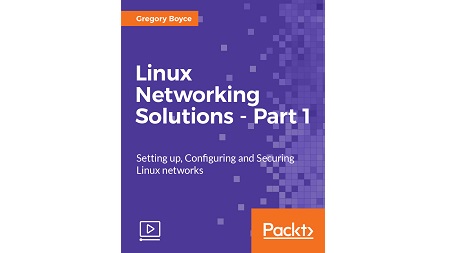
English | MP4 | AVC 1920×1080 | AAC 44KHz 2ch | 1h 58m | 430 MB
Learn to successfully set up, build, and manage your computer networks using Linux
We will first explore configuring a router. Initially, you will manually configure IP address information on your system and then properly configure the system to bring up its interfaces automatically. From there, we’ll move on to extend your system to act as a router for your own network, including DHCP for dynamically configuring client systems.
After that you will configure DNS. You will set up your internal DNS server to resolve external hostnames, and host DNS records for your own domain.
Next you will configure IPv6. Starting with a brief introduction to IPv6, you’ll configure a tunnel to provide IPv6 connectivity, implement firewalling using iptables6, and provide IPv6 addresses to the rest of your network.
Next you will look at remote access and explore methods for remotely interacting with your new network using OpenSSH and OpenVPN.
Finally you will explore Web Servers; here you will set up web servers hosting PHP code, using both the Apache HTTPD server and NGINX.
What You Will Learn
- Setting up a physical network
- Configuring IPv4
- Setting up DHCP
- Setting up your system to talk to a nameserver
- Configuring dynamic DNS on your local network
- Setting up an IPv6 tunnel via Hurricane Electric
- Installing OpenSSH
- Using OpenVPN
- Configuring Apache with TLS
Table of Contents
01 The Course Overview
02 Setting Up the Physical Network
03 Configuring IPv4
04 Configuring IPv4 Permanently
05 Connecting Two Networks
06 Enabling NAT to the Outside
07 Setting Up DHCP
08 Setting Up a Firewall with iptables
09 Setting Up Port Forwarding
10 Adding VLAN Tagging
11 Setting Up Your System to Talk to a nameserver
12 Setting Up a Local Recursive Resolver
13 Configuring Dynamic DNS on Your Local Network
14 Setting Up a nameserver for Your Public Domain
15 Setting Up a Slave nameserver
16 Setting Up an IPv6 Tunnel Via Hurricane Electric
17 Using ip6tables to Firewall Your IPv6 Traffic
18 Route an IPv6 netblock to Your Local Network
19 Installing OpenSSH
20 Using OpenSSH as a Basic Shell Client
21 Using OpenSSH to Forward Defined Ports
22 Using OpenSSH as a SOCKS Proxy
23 Using OpenVPN
24 Configuring Apache with TLS
25 Improving Scaling with the Worker MPM
26 Setting Up PHP Using an Apache Module
27 Securing Your Web Applications Using mod_security
28 Configuring NGINX with TLS
29 Setting Up PHP in NGINX with FastCGI
Resolve the captcha to access the links!